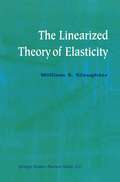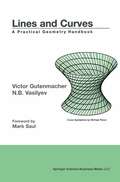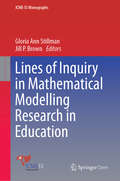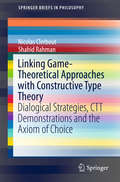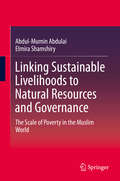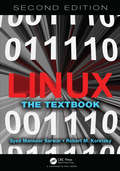- Table View
- List View
Linearization Methods for Stochastic Dynamic Systems (Lecture Notes in Physics #730)
by Leslaw SochaFor most cases of interest, exact solutions to nonlinear equations describing stochastic dynamical systems are not available. This book details the relatively simple and popular linearization techniques available, covering theory as well as application. It examines models with continuous external and parametric excitations, those that cover the majority of known approaches.
Linearization Models for Complex Dynamical Systems: Topics in Univalent Functions, Functional Equations and Semigroup Theory (Operator Theory: Advances and Applications #208)
by Mark Elin David ShoikhetLinearization models for discrete and continuous time dynamical systems are the driving forces for modern geometric function theory and composition operator theory on function spaces. This book focuses on a systematic survey and detailed treatment of linearization models for one-parameter semigroups, Schröder’s and Abel’s functional equations, and various classes of univalent functions which serve as intertwining mappings for nonlinear and linear semigroups. These topics are applicable to the study of problems in complex analysis, stochastic and evolution processes and approximation theory.
Linearization of Nonlinear Control Systems
by Hong-Gi LeeThis textbook helps graduate level student to understand easily the linearization of nonlinear control system. Differential geometry is essential to understand the linearization problems of the control nonlinear systems. In this book, the basics of differential geometry needed in linearization are explained on the Euclidean space instead of the manifold for students who are not accustomed to differential geometry. Many Lie algebra formulas, used often in linearization, are also provided with proof. The conditions in the linearization problems are complicated to check because the Lie bracket calculation of vector fields by hand needs much concentration and time. This book provides MATLAB programs for most of the theorems. The book also includes end-of-chapter problems and other pedagogical aids to help understanding and self study.
The Linearized Theory of Elasticity
by William S. SlaughterThis book is derived from notes used in teaching a first-year graduate-level course in elasticity in the Department of Mechanical Engineering at the University of Pittsburgh. This is a modern treatment of the linearized theory of elasticity, which is presented as a specialization of the general theory of continuum mechanics. It includes a comprehensive introduction to tensor analysis, a rigorous development of the governing field equations with an emphasis on recognizing the assumptions and approximations in herent in the linearized theory, specification of boundary conditions, and a survey of solution methods for important classes of problems. Two- and three-dimensional problems, torsion of noncircular cylinders, variational methods, and complex variable methods are covered. This book is intended as the text for a first-year graduate course in me chanical or civil engineering. Sufficient depth is provided such that the text can be used without a prerequisite course in continuum mechanics, and the material is presented in such a way as to prepare students for subsequent courses in nonlinear elasticity, inelasticity, and fracture mechanics. Alter natively, for a course that is preceded by a course in continuum mechanics, there is enough additional content for a full semester of linearized elasticity.
Lines and Curves: A Practical Geometry Handbook
by Victor Gutenmacher N.B. VasilyevBroad appeal to undergraduate teachers, students, and engineers; Concise descriptions of properties of basic planar curves from different perspectives; useful handbook for software engineers; A special chapter---"Geometry on the Web"---will further enhance the usefulness of this book as an informal tutorial resource.; Good mathematical notation, descriptions of properties of lines and curves, and the illustration of geometric concepts facilitate the design of computer graphics tools and computer animation.; Video game designers, for example, will find a clear discussion and illustration of hard-to-understand trajectory design concepts.; Good supplementary text for geometry courses at the undergraduate and advanced high school levels
Lines of Inquiry in Mathematical Modelling Research in Education (ICME-13 Monographs)
by Gloria Ann Stillman Jill P. BrownThis open access book is based on selected presentations from Topic Study Group 21: Mathematical Applications and Modelling in the Teaching and Learning of Mathematics at the 13th International Congress on Mathematical Education (ICME 13), held in Hamburg, Germany on July 24–31, 2016. It contributes to the theory, research and teaching practice concerning this key topic by taking into account the importance of relations between mathematics and the real world. Further, the book addresses the “balancing act” between developing students’ modelling skills on the one hand, and using modelling to help them learn mathematics on the other, which arises from the integration of modelling into classrooms. The contributions, prepared by authors from 9 countries, reflect the spectrum of international debates on the topic, and the examples presented span schooling from years 1 to 12, teacher education, and teaching modelling at the tertiary level. In addition the book highlights professional learning and development for in-service teachers, particularly in systems where the introduction of modelling into curricula means reassessing how mathematics is taught. Given its scope, the book will appeal to researchers and teacher educators in mathematics education, as well as pre-service teachers and school and university educators
Lines of symmetry (large print)
by RnibThis page shows six symmetrical shapes. There is a locator dot shown, which will be at the top left, when the image is the correct way up. Each shape has a dotted line running through its middle which is the line of symmetry or mirror line. The two shapes in the middle of the page have two lines of symmetry at right angles to each other. The shape in the top left is a circle with a diagonal line and in the top right a treble headed arrow. In the middle left a plus or cross in a diamond box shape and on the right a circle with a short horizontal bar. In the bottom left an exclamation mark in a triangle and in the bottom right an aeroplane symbol.
Lines of symmetry (UEB contracted)
by RnibThis page shows six symmetrical shapes. There is a locator dot shown, which will be at the top left, when the image is the correct way up. Each shape has a dotted line running through its middle which is the line of symmetry or mirror line. The two shapes in the middle of the page have two lines of symmetry at right angles to each other. The shape in the top left is a circle with a diagonal line and in the top right a treble headed arrow. In the middle left a plus or cross in a diamond box shape and on the right a circle with a short horizontal bar. In the bottom left an exclamation mark in a triangle and in the bottom right an aeroplane symbol.
Lines of symmetry (UEB uncontracted)
by RnibThis page shows six symmetrical shapes. There is a locator dot shown, which will be at the top left, when the image is the correct way up. Each shape has a dotted line running through its middle which is the line of symmetry or mirror line. The two shapes in the middle of the page have two lines of symmetry at right angles to each other. The shape in the top left is a circle with a diagonal line and in the top right a treble headed arrow. In the middle left a plus or cross in a diamond box shape and on the right a circle with a short horizontal bar. In the bottom left an exclamation mark in a triangle and in the bottom right an aeroplane symbol.
Linguistic and Cultural Influences on Learning Mathematics (Psychology of Education and Instruction Series)
by Rodney R. Cocking Jose P. MestreThe combined impact of linguistic, cultural, educational and cognitive factors on mathematics learning is considered in this unique book. By uniting the diverse research models and perspectives of these fields, the contributors describe how language and cognitive factors can influence mathematical learning, thinking and problem solving. The authors contend that cognitive skills are heavily dependent upon linguistic skills and both are critical to the representational knowledge intimately linked to school achievement in mathematics.
Linguistic and Cultural Influences on Learning Mathematics (Psychology of Education and Instruction Series)
by Rodney R. Cocking and Jose P. MestreThe combined impact of linguistic, cultural, educational and cognitive factors on mathematics learning is considered in this unique book. By uniting the diverse research models and perspectives of these fields, the contributors describe how language and cognitive factors can influence mathematical learning, thinking and problem solving. The authors contend that cognitive skills are heavily dependent upon linguistic skills and both are critical to the representational knowledge intimately linked to school achievement in mathematics.
Linguistic Decision Making: Theory and Methods
by Zeshui XuThis book provides a systematic introduction to linguistic aggregation operators, linguistic preference relations, and various models and approaches to multi-attribute decision making with linguistic information. Offers practical examples, tables and figures.
Linguistic Expressions and Semantic Processing: A Practical Approach
by Alastair ButlerThis book introduces formal semantics techniques for a natural language processing audience. Methods discussed involve: (i) the denotational techniques used in model-theoretic semantics, which make it possible to determine whether a linguistic expression is true or false with respect to some model of the way things happen to be; and (ii) stages of interpretation, i.e., ways to arrive at meanings by evaluating and converting source linguistic expressions, possibly with respect to contexts, into output (logical) forms that could be used with (i). The book demonstrates that the methods allow wide coverage without compromising the quality of semantic analysis. Access to unrestricted, robust and accurate semantic analysis is widely regarded as an essential component for improving natural language processing tasks, such as: recognizing textual entailment, information extraction, summarization, automatic reply, and machine translation.
Liniendiagramme in der Wissenskommunikation: Eine mathematisch-didaktische Untersuchung
by Markus HelmerichWissen repräsentieren und kommunizieren zu können ist eine wichtige Voraussetzung für die Teilhabe an der heutigen Wissensgesellschaft. Liniendiagramme aus der Formalen Begriffsanalyse als Bestandteil einer Begrifflichen Wissensverarbeitung sind ein gutes Mittel, Kommunikation von Wissen zu ermöglichen und anzuregen. Ausgehend von einer philosophischen Betrachtung der Bedeutung von Liniendiagrammen in der Wissensverarbeitung werden Diagramme als Kommunikationsmittel vorgestellt, die eine Brücke zwischen Anwendern und mathematisch-logischen Darstellungen, sowie zwischen unserem Alltagsdenken und formalen Repräsentationen schlagen. Gute Liniendiagramme lassen sich hinsichtlich ihrer Ausdruckskraft und Stärke, Kommunikationsprozesse zu unterstützen in ihrer Bedeutung für Wissenskommunikation charakterisieren. Dafür wird identifiziert, welche Denkhandlungen bei der Erstellung und anschließenden Benutzung von Liniendiagrammen aktiviert und trainiert werden. Zum Abschluss werden didaktische Grundannahmen und konkrete Ausarbeitungen der Lernumgebung zur Formalen Begriffsanalyse vorgestellt.
Link Theory in Manifolds (Lecture Notes in Mathematics #1669)
by Uwe KaiserAny topological theory of knots and links should be based on simple ideas of intersection and linking. In this book, a general theory of link bordism in manifolds and universal constructions of linking numbers in oriented 3-manifolds are developed. In this way, classical concepts of link theory in the 3-spheres are generalized to a certain class of oriented 3-manifolds (submanifolds of rational homology 3-spheres). The techniques needed are described in the book but basic knowledge in topology and algebra is assumed. The book should be of interst to those working in topology, in particular knot theory and low-dimensional topology.
Linked: How Everything Is Connected to Everything Else and What It Means for Business, Science, and Everyday Life
by Jennifer Frangos Albert-laszlo BarabasiThe best-selling guide to network science, the revolutionary field that reveals the deep links between all forms of human social life A cocktail party. A terrorist cell. Ancient bacteria. An international conglomerate. All are networks, and all are a part of a surprising scientific revolution. In Linked, Albert-László Barabási, the nation's foremost expert in the new science of networks, takes us on an intellectual adventure to prove that social networks, corporations, and living organisms are more similar than previously thought. Barabási shows that grasping a full understanding of network science will someday allow us to design blue-chip businesses, stop the outbreak of deadly diseases, and influence the exchange of ideas and information. Just as James Gleick and the Erdos-Rényi model brought the discovery of chaos theory to the general public, Linked tells the story of the true science of the future and of experiments in statistical mechanics on the internet, all vital parts of what would eventually be called the Barabási-Albert model.
Linked Data: Evolving the Web into a Global Data Space (Synthesis Lectures on Data, Semantics, and Knowledge)
by Tom Heath Christian BizerThe World Wide Web has enabled the creation of a global information space comprising linked documents. As the Web becomes ever more enmeshed with our daily lives, there is a growing desire for direct access to raw data not currently available on the Web or bound up in hypertext documents. Linked Data provides a publishing paradigm in which not only documents, but also data, can be a first class citizen of the Web, thereby enabling the extension of the Web with a global data space based on open standards - the Web of Data. In this Synthesis lecture we provide readers with a detailed technical introduction to Linked Data. We begin by outlining the basic principles of Linked Data, including coverage of relevant aspects of Web architecture. The remainder of the text is based around two main themes - the publication and consumption of Linked Data. Drawing on a practical Linked Data scenario, we provide guidance and best practices on: architectural approaches to publishing Linked Data; choosing URIs and vocabularies to identify and describe resources; deciding what data to return in a description of a resource on the Web; methods and frameworks for automated linking of data sets; and testing and debugging approaches for Linked Data deployments. We give an overview of existing Linked Data applications and then examine the architectures that are used to consume Linked Data from the Web, alongside existing tools and frameworks that enable these. Readers can expect to gain a rich technical understanding of Linked Data fundamentals, as the basis for application development, research or further study. Table of Contents: List of Figures / Introduction / Principles of Linked Data / The Web of Data / Linked Data Design Considerations / Recipes for Publishing Linked Data / Consuming Linked Data / Summary and Outlook
Linked Data Visualization: Techniques, Tools, and Big Data (Synthesis Lectures on Data, Semantics, and Knowledge)
by Laura Po Nikos Bikakis Federico Desimoni George PapastefanatosLinked Data (LD) is a well-established standard for publishing and managing structured information on the Web, gathering and bridging together knowledge from different scientific and commercial domains. The development of Linked Data Visualization techniques and tools has been followed as the primary means for the analysis of this vast amount of information by data scientists, domain experts, business users, and citizens. This book covers a wide spectrum of visualization issues, providing an overview of the recent advances in this area, focusing on techniques, tools, and use cases of visualization and visual analysis of LD. It presents the basic concepts related to data visualization and the LD technologies, the techniques employed for data visualization based on the characteristics of data techniques for Big Data visualization, use tools and use cases in the LD context, and finally a thorough assessment of the usability of these tools under different scenarios. The purpose of this book is to offer a complete guide to the evolution of LD visualization for interested readers from any background and to empower them to get started with the visual analysis of such data. This book can serve as a course textbook or a primer for all those interested in LD and data visualization.
Linking and Aligning Scores and Scales (Statistics for Social and Behavioral Sciences)
by Mary Pommerich Paul W. Holland Neil J. DoransIn this book, experts in statistics and psychometrics describe classes of linkages, the history of score linkings, data collection designs, and methods used to achieve sound score linkages. They describe and critically discuss applications to a variety of domains. They define what linking is, to distinguish among the varieties of linking and to describe different procedure for linking. Furthermore, they convey the complexity and diversity of linking by covering different areas of linking and providing diverse perspectives.
Linking Game-Theoretical Approaches with Constructive Type Theory: Dialogical Strategies, CTT demonstrations and the Axiom of Choice (SpringerBriefs in Philosophy)
by Nicolas Clerbout Shahid RahmanThis title links two of the most dominant research streams in philosophy of logic, namely game theory and proof theory. As the work’s subtitle expresses, the authors will build this link by means of the dialogical approach to logic. One important aspect of the present study is that the authors restrict themselves to the logically valid fragment of Constructive Type Theory (CTT). The reason is that, once that fragment is achieved the result can be extended to cover the whole CTT system. The first chapters in the brief offer overviews on the two frameworks discussed in the book with an emphasis on the dialogical framework. The third chapter demonstrates the left-to-right direction of the equivalence result. This is followed by a chapter that demonstrates the use of the algorithm in showing how to transform a specific winning strategy into a CCT-demonstration of the axiom of choice. The fifth chapter develops the algorithm from CTT-demonstrations to dialogical strategies. This brief concludes by introducing elements of discussion which are to be developed in subsequent work.
Linking Methods in Critical Point Theory
by Martin SchechterAs is well known, The Great Divide (a.k.a. The Continental Divide) is formed by the Rocky Mountains stretching from north to south across North America. It creates a virtual "stone wall" so high that wind, rain, snow, etc. cannot cross it. This keeps the weather distinct on both sides. Since railroad trains cannot climb steep grades and tunnels through these mountains are almost formidable, the Canadian Pacific Railroad searched for a mountain pass providing the lowest grade for its tracks. Employees discovered a suitable mountain pass, called the Kicking Horse Pass, el. 5404 ft., near Banff, Alberta. (One can speculate as to the reason for the name.) This pass is also used by the Trans-Canada Highway. At the highest point of the pass the railroad tracks are horizontal with mountains rising on both sides. A mountain stream divides into two branches, one flowing into the Atlantic Ocean and the other into the Pacific. One can literally stand (as the author did) with one foot in the Atlantic Ocean and the other in the Pacific. The author has observed many mountain passes in the Rocky Mountains and Alps. What connections do mountain passes have with nonlinear partial dif ferential equations? To find out, read on ...
Linking Sustainable Livelihoods to Natural Resources and Governance: The Scale of Poverty in the Muslim World
by Abdul-Mumin Abdulai Elmira ShamshiryThis book investigates the current level and trend of poverty in the Muslim World, including selected countries in Africa, the Middle East and Central Asia, East Asia, the Pacific and South America. Authors explore themes of poverty reduction, poverty alleviation and the extent of influences on social and economic development, particularly natural resource endowments (especially mineral resources) and their utilization. Chapters explore theory and practice, including governance and programmes, and take a detailed look at Zakat as a faith-based policy tool, to reduce poverty and improve livelihoods and thus contribute to better environmental stewardship. The final chapters look at development questions in the Muslim World and make policy recommendations, including a proposed multi-dimensional development collaboration model called the Development Collaboration Octagon Model (DeCOM). Readers will discover theoretical explanations of poverty and how poverty hampers the development of many nations because the poor are unable to partake actively in the development process. Poverty indicators and measurement are discussed, and trends of economic growth including productivity, manufacturing, trade patterns, investment and saving activity, and socio-economic developments are all explored: supporting data is presented in tables and figures, throughout this text. Authors explore the potency and success stories of public poverty alleviation strategies and programmes pursued in the Muslim world, especially the extent to which the institution of Zakat has been effectively incorporated into public poverty alleviation strategies. Policy options required to enhance social and economic development are proposed, to help pull the poor out of the poverty trap into the mainstream economy in the Muslim world. This work will appeal to anyone wishing to scrutinise poverty, its parameters and its relationship with the development of countries in the Muslim world. Scholars in the fields of economics, sociology, geography and Islamic studies will all find something of value here.
Linux: The Textbook, Second Edition
by Syed Mansoor Sarwar Robert M KoretskyLinux: The Textbook, Second Edition provides comprehensive coverage of the contemporary use of the Linux operating system for every level of student or practitioner, from beginners to advanced users. The text clearly illustrates system-specific commands and features using Debian-family Debian, Ubuntu, and Linux Mint, and RHEL-family CentOS, and stresses universal commands and features that are critical to all Linux distributions. The second edition of the book includes extensive updates and new chapters on system administration for desktop, stand-alone PCs, and server-class computers; API for system programming, including thread programming with pthreads; virtualization methodologies; and an extensive tutorial on systemd service management. Brand new online content on the CRC Press website includes an instructor’s workbook, test bank, and In-Chapter exercise solutions, as well as full downloadable chapters on Python Version 3.5 programming, ZFS, TC shell programming, advanced system programming, and more. An author-hosted GitHub website also features updates, further references, and errata. Features New or updated coverage of file system, sorting, regular expressions, directory and file searching, file compression and encryption, shell scripting, system programming, client-server–based network programming, thread programming with pthreads, and system administration Extensive in-text pedagogy, including chapter objectives, student projects, and basic and advanced student exercises for every chapter Expansive electronic downloads offer advanced content on Python, ZFS, TC shell scripting, advanced system programming, internetworking with Linux TCP/IP, and many more topics, all featured on the CRC Press website Downloadable test bank, work book, and solutions available for instructors on the CRC Press website Author-maintained GitHub repository provides other resources, such as live links to further references, updates, and errata
Linux: The Textbook, Second Edition
by Syed Mansoor Sarwar Robert M KoretskyChoosen by BookAuthority as one of BookAuthority's Best Linux Mint Books of All Time Linux: The Textbook, Second Edition provides comprehensive coverage of the contemporary use of the Linux operating system for every level of student or practitioner, from beginners to advanced users. The text clearly illustrates system-specific commands and features using Debian-family Debian, Ubuntu, and Linux Mint, and RHEL-family CentOS, and stresses universal commands and features that are critical to all Linux distributions. The second edition of the book includes extensive updates and new chapters on system administration for desktop, stand-alone PCs, and server-class computers; API for system programming, including thread programming with pthreads; virtualization methodologies; and an extensive tutorial on systemd service management. Brand new online content on the CRC Press website includes an instructor’s workbook, test bank, and In-Chapter exercise solutions, as well as full downloadable chapters on Python Version 3.5 programming, ZFS, TC shell programming, advanced system programming, and more. An author-hosted GitHub website also features updates, further references, and errata. Features New or updated coverage of file system, sorting, regular expressions, directory and file searching, file compression and encryption, shell scripting, system programming, client-server–based network programming, thread programming with pthreads, and system administration Extensive in-text pedagogy, including chapter objectives, student projects, and basic and advanced student exercises for every chapter Expansive electronic downloads offer advanced content on Python, ZFS, TC shell scripting, advanced system programming, internetworking with Linux TCP/IP, and many more topics, all featured on the CRC Press website Downloadable test bank, work book, and solutions available for instructors on the CRC Press website Author-maintained GitHub repository provides other resources, such as live links to further references, updates, and errata



